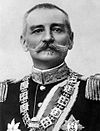- Portal:Serbia
-
- Wikipedia portals:
- Culture
- Geography
- Health
- History
- Mathematics
- Natural sciences
- People
- Philosophy
- Religion
- Society
- Technology
Serbia - Србија - Srbija 
Serbia, officially the Republic of Serbia (Serbian: Република Србија or Republika Srbija), is a country in central and southeastern Europe, covering the central part of the Balkan Peninsula and the southern part of the Pannonian Plain. The capital is Belgrade. Serbia borders Hungary to the north; Romania and Bulgaria to the east; the Republic of Macedonia and Albania to the south; and Montenegro, Croatia, and Bosnia and Herzegovina to the west.
Serbia was part of various South Slavic states, including the Kingdom of the Serbs, Croats and Slovenes from 1918 to 1941, the Socialist Federal Republic of Yugoslavia from 1945 to 1992, the Federal Republic of Yugoslavia from 1992 to 2003, and the State Union of Serbia and Montenegro from 2003 to 2006. After Montenegro voted to leave the State Union, Serbia officially proclaimed its independence on June 5, 2006, as the successor state to the State Union of Serbia and Montenegro.
Selected article
 Orthodox priest places the badnjak on the fire during Christmas Eve celebration at the Cathedral of Saint Sava in Belgrade.
Orthodox priest places the badnjak on the fire during Christmas Eve celebration at the Cathedral of Saint Sava in Belgrade.
The badnjak (Cyrillic: бадњак, Serbian pronunciation: [ˈbǎdɲaːk]), also called veseljak (весељак, [ʋɛˈsɛ̌ʎaːk], literally "jovial one" in Serbian), is represented by three types of objects in Serbian Christmas celebrations. The oldest type is a log brought into the house and placed on the fire on the evening of Christmas Eve,[Note 1] much like a yule log in other European traditions. The tree from which the log is cut, preferably a young and straight oak, is ceremonially felled early on the morning of Christmas Eve. The felling, preparation, bringing in, and laying on the fire, are surrounded by elaborate rituals, with many regional variations. The burning of the log is accompanied by prayers that the coming year brings food, happiness, love, luck, and riches. The log burns on throughout Christmas Day, when the first visitor strikes it with a poker or a branch to make sparks fly, requesting that the family's happiness and prosperity be as abundant as the sparks. Another type of the badnjak that has developed among the Serbs has mostly replaced the traditional log, whose burning is usually unfeasible in modern homes. It is a cluster of oak twigs with brown leaves attached, with which the home is decorated on the Eve.
Further information: BadnjakSerbia news
Wikinews Serbia portal- June 1: Ratko Mladić said to be too ill to face trial
- May 28: Ratko Mladić arrested for war crimes
- May 15: Azerbaijan win 2011 Eurovision Song Contest
- November 21: Serb pilots defend colleague in Air India Express disaster
- October 1: Man dies in Serbian enclave; could not call ambulance
Selected picture

Studenica Monastery, a Monument of Culture of Exceptional Importance and also a World Heritage Site.Did you know
...that famous supermodel Adriana Lima married Serbian NBA player Marko Jaric?
...that Serbia regained independence in 2006?
...that famous writer John Ronald Reuel Tolkien tried to learn the Serbian language but failed?
...that actress and model Milla Jovovich has origins in the Serb tribe of Vasojevići?
...that Belgrade was under some form of attack every 37 years on average since AD 1?
...that Belgrade was battled over in 115 wars and razed to the ground 44 times
...that Serbia had the highest GDP growth rate in Europe in 2005 and 2006?
...that Serbia grows over a third of the world's raspberries and it is the largest exporter of frozen fruit in the world?
...that Serbian language is almost the same as Croatian and Bosnakian?
Web resources
- Serbian Government
- National Assembly of Serbia
- The EU integration Office of Serbian Government
- People's Office of Serbian President
- National Bank of Serbia
- RTS - Serbian Broadcasting Corporation
- Republic of Serbia Statistical Office
WikiProjects
- Parent projects
WikiProject Countries • WikiProject Europe

- Main project
New Articles
- Sister projects
WikiProject Belgrade • WikiProject Cultural Heritage of Serbia
What are WikiProjects?
Demographics
- Population statistics of Serbia (Estimate May 2005)
- Serbia (total): 9,396,411
- Vojvodina: 2,116,725
- Central Serbia: 5,479,686
- Kosovo: 1,800,000
Things you can do

Here are some tasks you can do:- Article requests: Law of Serbia - Taxation in Serbia - Nisomnia - Vuko Darmanović - Janko Šafarik - Buljarice - Debelo Brdo - Energoprojekt - Serbian Chamber of Commerce - Pevačko društvo "Stanković" - Delfa Ivanić - Stefan Zanović - Antonije Znorić - Emanuel Kozačinski
- Copyedit: Suvača
- Expand: History of Belgrade - Nikola Petrović - Dositej Obradović - Konstantin Mihailović - Branislav Nušić - Desanka Maksimović - Ljubica Marić - Stari Grad, Užice - Belgrade Beer Fest - Historical population of Belgrade - Politika - Vesna Trivalić - Rascia - Miloš Popović - Belgrade Zoo - BEMUS - Šajkača - Memorial Chapel - Ljubivoje Ršumović - Žiča - Đavolja Varoš - Lapot
- Photo: Add photos to the list categories. Search from sr wiki and on commons.
- Stubs: See Category:Stub-Class Serbia articles
- Other: Expand Serbia-related orphaned articles
Selected biography
Peter I (Serbian: Petar I Karađorđević, Петар I Карађорђевић) (29 June 1844 – 16 August 1921), was King of Serbia from 1903 to 1918, and subsequently the ruler of Kingdom of the Serbs, Croats and Slovenes (later 1929 Kingdom of Yugoslavia). He was member of the Royal House of Karađorđević. As the leader of victorious Serbian army in World War I, he also received the nickname "Liberator" (Oslobodilac) after the war. The Western-educated King attempted to liberalise Serbia with the goal of creating a Western-style constitutional monarchy, even translating John Stuart Mill's "On Liberty" into Serbian. Peter chose to "retire" due to ill health following the Balkan Wars which, from a Serb perspective, were a great success. Executive power passed to his son Alexander. The King was relatively inactive during the First World War, although he did occasionally visit trenches to check up on his troops. One memorable visit in 1915 involved Peter, by then 71, picking up a rifle and shooting at enemy soldiers. Following Serbia's military defeat to the forces of Austro-Hungary Peter led the army and civilian refugees through the mountains to the sea on a 'Calvary known to few peoples'. The King had on 24 June 1914 reassigned his royal prerogatives to the Heir apparent Crown Prince Alexander. His last public appearance was on 1 December 1918, when he was proclaimed King of the Serbs, Croats and Slovenes. King Peter I died in Belgrade in 1921 at the age of 77.
Serbian people
Politicians
Category:Serbian politicians
- Zoran Đinđić
- Vojislav Koštunica
- Tomislav Nikolić
- Boris Tadić
- Mirko Cvetković
- Ivica Dačić
- Vuk Drašković
- Čedomir Jovanović
- Mlađan Dinkić
- Nenad Čanak
- Veroljub Stevanović
Saints
- Saint Danilo II
- Saint Jovan Vladimir
- Saint Hieromartyr Lazar
- Saint Justin Popović
- Saint Nikolai Velimirović
- Saint Peter of Cetinje
- Saint Sava
- Saint Simeon
- Saint Stephen of Piperi
- Saint Vasilije
Scientists & Inventors
Category:Serbian scientists
- Nikola Tesla
- Milutin Milanković
- Mileva Marić
- Mihajlo Pupin
- Josif Pančić
- Jovan Cvijić
- Vuk Stefanović Karadžić
- Pavle Savić
Athletes
Category:Serbian sportspeople
- Dragan Džajić
- Dejan Stanković
- Nemanja Vidić
- Mateja Kežman
- Borislav Stanković
- Radivoj Korać
- Vlade Divac
- Aleksandar Đorđević
- Predrag Stojaković
- Dejan Bodiroga
- Novak Đoković
- Jelena Janković
- Ana Ivanović
- Milorad Čavić
Artists
Connected to Serbs or Serbia
- Madeleine Albright (saved by Serbs in Second World War, but was one of the main proponents of 1999 NATO war on Serbia)
- Josip Broz (ruled Serbia as part of Yugoslavia for 35 years)
- Albert Einstein (was married to Mileva Maric)
- Yosef Lapid (born in Serbia)
- Thomas Nagel (born in Serbia)
- Monica Seles (tennis player, played for Yugoslavia; an ethnic Hungarian born in Serbia, Vojvodina)
- Sir John Tavener (composed: The Epistile of Love and The Veil of the Temple on Serbian Medieval Poetry)
- Constantine the Great (born on territory of Serbia)
Serbian Cities
Major categories
[×] Time in Serbia[×] Serbia portalMajor topics
Related portals
European Union Hungary Romania Bulgaria Rep. Macedonia Albania Montenegro Bosnia and Herzegovina Croatia Associated Wikimedia
Cite error: There are<ref>tags on this page, but the references will not show without a{{Reflist|group=Note}}template or a<references group="Note"/>tag; see the help page.Categories:- Serbia
- European portals
- Serbia portal
Wikimedia Foundation. 2010.




